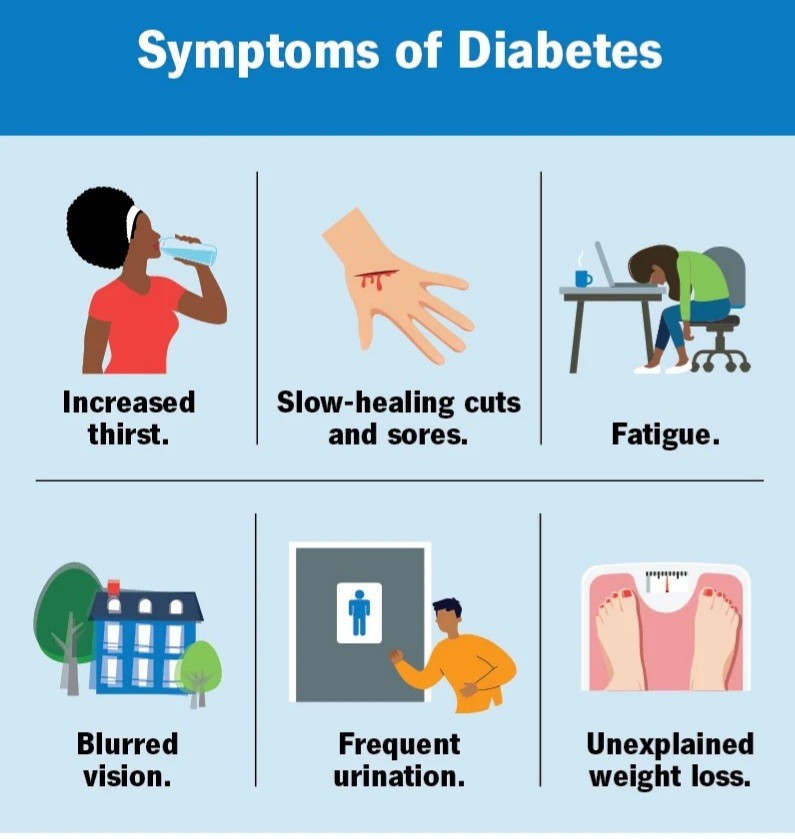A person suffering from diabetes is a conditionally healthy person
Statement by the famous diabetologist Eliot Joslin: Diabetes mellitus is a disease of modern times. With adequate, long-term treatment, motivation and education, such people can live a completely normal life. In this way, chronic complications can be avoided. Recent technical and technological improvements in diabetes therapy also contribute to such a successful course of this disease.
Diabetes mellitus is a chronic, progressive disease. This disease is characterized by a chronically increased level of glucose in the blood, which is the result of insufficient secretion of insulin or reduced action of insulin, and may be the result of associated disorders.
In people who do not have diabetes, normal blood sugar values are from 3.3 mmol/L to 6.1 mmol/L. After a meal, the value of glucose (sugar) can rise up to 7.8 mmol/L, but after 2 hours it reaches normal values.
Why do we say it is a chronic disease?
It is chronic because it lasts a long time, i.e. it is most often a lifelong disease. It cannot be completely cured, but it can be kept under control with adequate therapy and lifestyle changes. Chronic hyperglycemia (increased blood glucose concentration) is associated with damage and dysfunction of many organs, such as eyes, kidneys, heart, blood vessels and nerves. Because of this, diabetes mellitus is the main cause of terminal stage renal failure, blindness, amputation of lower limbs, stroke, myocardial infarction.
As for the prevalence of this disease in the population, it is believed that by 2045, the number of people suffering from diabetes will amount to about 7 million people, and therefore, due to the increasing number of patients, diabetes mellitus is taking the form of a pandemic.
Classification of diabetes and how is it diagnosed
The classification of diabetes mellitus is based on the pathological processes that lead to hyperglycemia, so we have two types:
1) Diabetes mellitus type I – occurs in children and adolescents, and can also occur in adults up to 30 years old.
2) Diabetes mellitus type II – occurs in adults and is increasingly common in young people, over 30 years old.
Diabetes mellitus type I occurs due to a complete or partial lack of insulin, while diabetes mellitus type II occurs as a result of several disorders, such as: the degree of insulin resistance, increased glucose production, as well as a disorder in the secretion of pancreatic hormones (insulin). In addition to these two types of diabetes, there are many other specific types that can be caused by genetic factors, medications, pancreatic diseases, as well as various infections.
The criteria for the diagnosis of diabetes are:
– HbA1c ≥ 6.5%.
– Fasting glucose ≥ 7.00 mmol/L.
– 2h after oral glucose load (OGTT) ≥ 11.1 mmol/L.
– Measured glucose in any blood sample ≥ 11.1 mmol/L.
What is gestational diabetes and how is it diagnosed?
When an increased level of glucose in the blood occurs for the first time during pregnancy, this form of diabetes is called gestational diabetes. According to the latest criteria, the diagnosis of gestational diabetes (diabetes during pregnancy) is made if a value of 5.1 – 7.00 mmol/L is found in only one blood glucose measurement at the first control during pregnancy. If the initial test is normal, an oral stress test (OGTT) is performed between the 24th and 28th week of pregnancy.
The basic criteria for the diagnosis of diabetes in pregnancy are:
– Fasting venous plasma glucose greater than or equal to 5.1 mmol/L.
– OGTT: glucose after one hour greater than or equal to 10.00 mmol/L.
– OGTT: glucose after two hours greater than or equal to 8.5 mmol/L.
– In gestational diabetes, an elevated blood glucose level occurs for the first time during pregnancy, and the sugar level normalizes after delivery. If the high level of glucose in the blood continues even after childbirth, then it was newly discovered diabetes during pregnancy.

What are the symptoms of diabetes mellitus?
Diabetes mellitus type I is a form that occurs suddenly and may include the following symptoms: frequent urination, excessive thirst, dry mouth, severe fatigue (lack of energy), constant hunger, sudden weight loss, blurred vision, frequent infections.
Diabetes mellitus type II, formerly known as insulin-independent type of diabetes. It is represented a lot more, includes about 90% of all patients. The symptoms of this form are much milder, they are more severe diagnose, and sometimes they can be absent, so the disease is diagnosed when they have already appeared complications.
The most common acute complication of diabetes is hypoglycemia (low blood glucose concentration). Hypoglycemia occurs when the patient applies an excessive dose of insulin, due to irregular meals, increased physical activity, as well as due to intake of large amounts of alcohol. The first signs of hypoglycemia are: sweating, rapid heartbeat, tremors, hunger, pallor, dizziness.

What should you do in case of hypoglycemia?
Take a glucose-enriched food, which is a sweet drink (preferably a glass of coke), glucose candies or a meal that is enriched with a large amount of carbohydrates.
Garlic and diabetes: How does fermented garlic work in people with diabetes?
Alvitpharm brand preparations contain black garlic (fermented garlic) in its composition, which has been proven to have a hypoglycemic effect (they reduce the increased level of glucose in the blood). The amino acid S-allyl-L-cysteine is an organic compound whose concentration is many times higher in fermented garlic compared to fresh garlic. According to the conclusion of a large number of studies, S-allyl-L-cysteine, as the main bioactive compound of black garlic, has the potential to act hypoglycemic (reduces the level of sugar in the blood) and hypolipidemic (reduces the level of fat in the blood) with minimal side effects, which is not the case with conventional therapy in the treatment of these conditions.
Using S-allyl-L-cysteine improves both metabolic and vascular changes, which reduces the possibility of various complications. It has been proven to reduce the concentration of glucose, glycosylated hemoglobin (HbA1c), urea, creatinine and uric acid. S-allyl-L-cysteine has a positive effect on the level of liver enzymes, so it is proven to reduce the level of aspartate transaminase (AST), alanine transaminase (ALT) and alkaline-phosphatase (ALP). What is particularly interesting is that the study that investigated this compared laboratory results after treatment with fermented garlic and with the drug, oral antidiabetic, gliclazide, and the results were almost identical, and with the use of fermented of garlic, the level of side effects was reduced in relation to pharmacotherapy. This means that S-allyl-L-cysteine could be considered a reliable agent in the therapy of diabetes mellitus, but it is still not true the mechanism of action of S-allyl-L-cysteine in such conditions has not been defined, nor has it been investigated. Very often it is increased level of sugar in the blood accompanied by increased level of cholesterol and triglycerides in the blood. Therefore, the control of hyperglycemia (increased blood sugar level) and hyperlipidemia (increased level blood fat) is strongly correlated with a reduced risk of cardiovascular complications. Many studies have proven that fermented garlic has the ability to reduce blood glucose levels, increases the level of insulin, and has a favorable effect on the body’s lipid status (reduces the value of the total cholesterol and triglycerides, and increases the value of HDL (good) cholesterol), and regulates appetite. Hyperglycemia represents oxidative stress, and since fermented garlic has a very strong antioxidant potential, it is recommended to use black garlic as a preventive measure, especially in persons who have a positive family history of diabetes. Also, because of the possibility that neutralizes free radicals, preparations based on black garlic are also recommended as a preventive measure to avoid them there were complications of diabetes, such as stroke, myocardial infarction, amputation of the lower limbs extremities, renal failure.
Lactobacillus bulgaricus, a probiotic strain, can improve the antioxidant capacity of fermented of garlic in the prevention of gestational diabetes mellitus, this was proven by one study in which 226 women with an increased risk of developing this disease participated.

References:
Antioxidant effect of garlic and aged black garlic in animal model of type 2 diabetes mellitus
Магистр фармации Radojka Kostić
